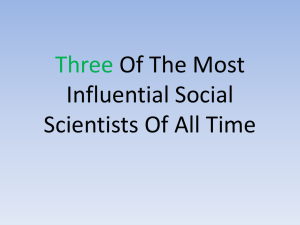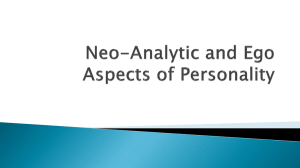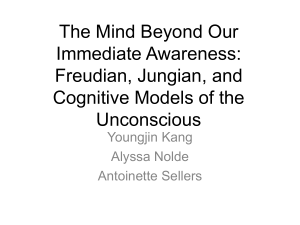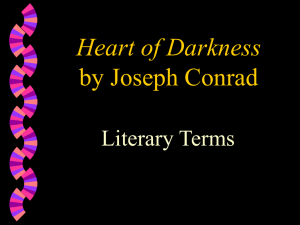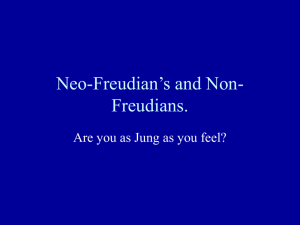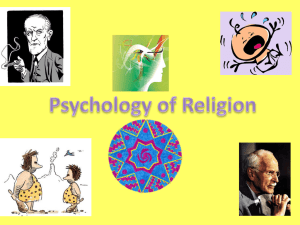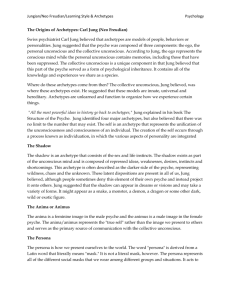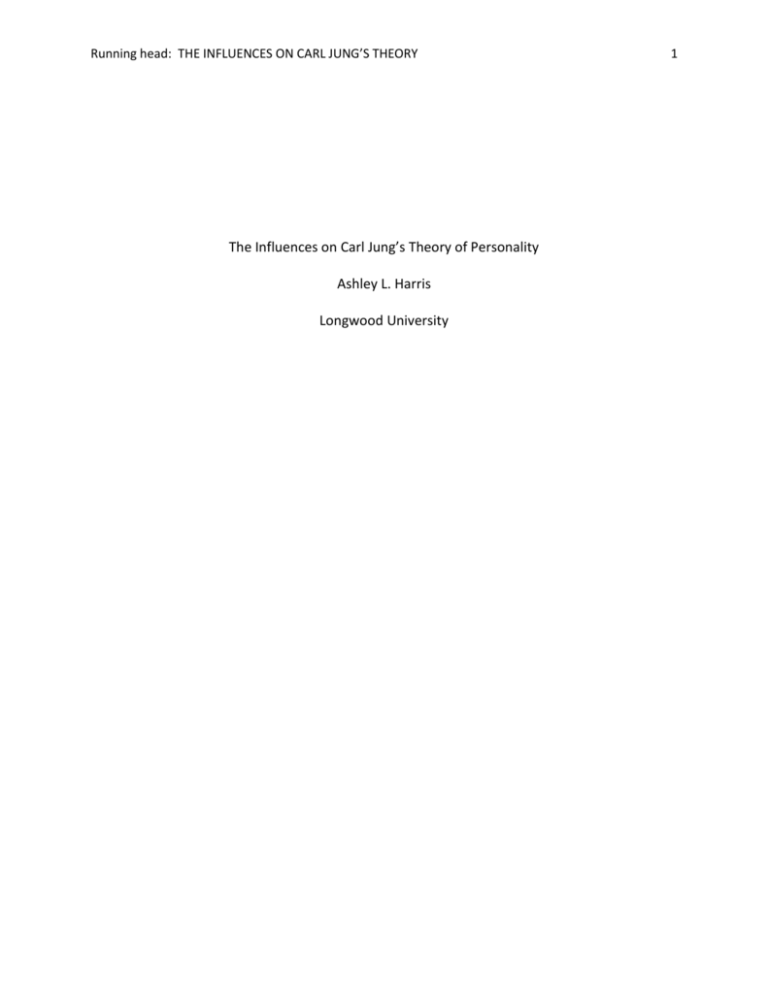
Running head: THE INFLUENCES ON CARL JUNG’S THEORY
The Influences on Carl Jung’s Theory of Personality
Ashley L. Harris
Longwood University
1
THE INFLUENCES ON CARL JUNG’S THEORY
2
Abstract
Carl Jung was influenced by his, parents, paranormal experiences during childhood, religious
affiliation, Sigmund Freud, college career, and his academic studies of theology, mythology, and
philosophy to develop his unique theory of personality. Jung’s theory of personality includes:
archetypes, individuation, the collective unconscious, libido, complexes, and personality types,
which later led to the Meyers-Briggs personality test and influenced other psychologists to
continue personality development. Jung began his psychology career with Freud conducting
psychoanalysis and then unfriended Freud to become a psychoanalyst with his own theories.
Jung is considered the father of analytical psychology.
Keywords: Carl Jung, complexes, individuation, archetypes, Sigmund Freud
THE INFLUENCES ON CARL JUNG’S THEORY
3
The Influences on Carl Jung’s Theory of Personality
There are multiple theories of personality in psychology; however, each theory is
unique. Carl Jung’s theories of personality are unique, inspired by his time spent with Sigmund
Freud, his family, Greek mythology, and Christianity, as well as other religions. Although Jung
collaborated with Freud for a portion of his younger years, Jung’s theory challenged that of
Freud’s and surpassed it in the scholarly psychological community (Freud, 1935). Jung’s
theories of archetypes, the collective conscious and unconscious mind, complexes, libido,
personality types, and the spiritual self all were inspired by Jung’s early influences of religion,
psychic-paranormal phenomenon, medicine, mythology, and philosophy (Jung, 1961).
Childhood and Early Adolescence
Carl Gustav Jung was born into an impoverished family on July 26, 1875 in Kesswil,
Switzerland to father, Johannes Paul Achilles Jung, and mother, Emilie Preiswerk. Jung was
raised in the rural countryside of Switzerland (Jung, 1961). Jung suffered from eczema and
another illness, which he does not clearly state in his biography, during his infancy. He believed
that the cause of his illness was due to the separation from his parents during his mother’s time
in the hospital (Jung, 1961). He also emphasized that his mother’s illness was due to his
parents’ marital predicaments. Jung viewed his mother as a complex individual because, in his
opinion, she exhibited signs of mental illness. For many years, Jung associated the word
woman with unreliability (Jung, 1961).
There were several successful paternal figures in Jung’s family on his mother and
father’s side. In Jung’s early childhood, Paul Jung was an influential pastor for most of his life,
as well as a classical scholar. However, later in Jung’s life his father became more passive and
THE INFLUENCES ON CARL JUNG’S THEORY
4
depressed. Carl Jung’s grandfather, Carl Jung Sr., was a surgeon and Grand Master of the
freemasons in Germany. His maternal grandfather was a Jewish theologist (Jung, 1961). Jung
grew up in a Christian, particularly Protestant, household. Jung’s mother read Orbis Pictus, a
children’s encyclopedia that portrayed multiple religions, animals, plants, natural scenes, and
humans, in an illustrated fashion (Comenius, 1887).
At around age 6 or 7, Jung began to have paranormal sensations. He reported seeing
decapitated figures floating in the air repeatedly and large blue moon-like circles with angels
dancing inside (Jung, 1961). Jung was suffering from choking fits and during most of the
choking fits is when he saw had a vision of suffocating to death. In turn, the fear of suffocating
caused anxiety dreams for Jung as a child (Jung, 1961).
Prior to starting school, Jung had learned to read and write. At six years old Jung began
school and his studies of religion, philosophy, and Latin taught to him by his father. Jung states
that one of his reasons for enjoying school was the ability to learn, as well as play with other
children. Jung’s sister was born nine years after him, so he did not have playmates until his
school years (Jung, 1961). His newly found playmates loved to play pranks; however, Jung felt
that the children around him made him change from his true self to someone he could not
recognize. Jung began to view the world as hostile and was slowly losing his sense of self and
security. He used to have a fire only he could tend to in his own hiding place, where he would
sit on a stone and watch the fire stir. Jung would pretend that the rock could talk and finally
came to question what was what and who was who. He was such an intelligent child that he
could contemplate basic philosophy between a human and an inanimate object (Jung, 1961).
THE INFLUENCES ON CARL JUNG’S THEORY
5
When Jung mentions his sister being born in 1884, he speaks of his new baby sister as
an object, rather than a human life. Jung describes his baby sister has being blood red with an
old man face and blind, which is not a traditional way to describe an infant (Jung, 1961). He
spoke of his mother lying in bed more frequently and assumed it was an inexcusable weakness
because he viewed his mother as weak. The birth of Jung’s sister caused him to feel a sense of
distrust and curiosity towards life and that something regrettable was connected to his sister’s
birth (Jung, 1961).
At 11 years old, Jung moved to a school in Basel, Switzerland, in which he was
surrounded by boys of wealth and realized that he was the son of a poor rural parson. Jung,
although a brilliant child, hardly understood algebra or any kind of mathematics. He could not
grasp basic functions and concepts of algebra (Jung, 1961). As well as Jung’s hatred for
mathematics, he also hated gymnastics class and refused to participate because he believed
that school was for knowledge only, not acrobatics. Due to Jung’s lack of athleticism, he claims
he developed a distrust for the world and its potential. However, Jung’s fainting spells led to his
absences of gymnastics and an overall happiness from the expulsion of school (Jung, 1961).
During Jung’s absence of school, his fainting spells worsened. Doctors believed Jung
suffered from epilepsy; however, that is not why he had fainting spells. Although epilepsy was
not the cause of his fainting spells, he does not explain the true cause of his fainting spells in his
writings (Jung, 1961). When overhearing a conversation between his father and a family friend
worrying if Jung will ever be able to work for a living with his condition, Jung began to become
serious about his studies. He studied for hours at a time, beginning at 5:30 in the morning past
midnight the next day with a few hours of sleep in between. By being obsessed with his
THE INFLUENCES ON CARL JUNG’S THEORY
6
studies, Jung said that he found his true self and no longer distrusted the word because the
world had new potential for him. (Jung, 1961).
College Years and Beginning Interest in Psychology
In 1895, Jung began his freshman year at the University of Basel studying medicine.
Jung battled with the choice of choosing science or religion for his professional study. He had
nightly dreams of which he believed God was attempting to tell him which path to choose for
his profession (Jung, 1961). Jung became part of a fraternity, which was a group of men
discussing academics, typically around a fire at night, but sometimes in the country. This
fraternity was important to Jung because his father was a part of the same organization, so he
felt as if he finally had a connection with his father (Jung, 1961).
During his second year of college, in 1896, Jung’s father, Paul Jung, died. Jung was now
responsible for the family. However, Jung’s uncles on both sides of his family helped his
family’s financial situation and paid for his college tuition (Jung, 1961). With the passing of
Jung’s father, Jung became good friends with his father’s former friend and colleague, Father
Victor White (Jung, 1939). He taught Jung theology, specifically Protestant and Roman Catholic
theology, and the two debated theological and philosophical theories. White and Jung often
debated each other’s writings. White was particularly critical of Jung’s On the Self and accused
him of being a dualist, meaning that there is a mind and body that work together, rather than
God controlling the body (Jung, 1939; Jung, 1957). By this time, Jung was spending more time
contemplating the theories of theology and psychology, more so than medicine (Jung, 1961).
However, after an introductory course into medicine, Jung became a junior assistant in
anatomy and with that he became thoroughly interested in evolutionary theory and
THE INFLUENCES ON CARL JUNG’S THEORY
7
comparative anatomy. His new position left only weekends to study theology, philosophy, and
psychology (Jung, 1961).
In 1898, Jung began to think more seriously of his medical degree and the field of
opportunities that were ahead of him. He decided he wanted to work in a local hospital until
he found further opportunities (Jung, 1961). However, strange phenomenon began to happen
in the Jung household. Furniture began to crack without any notice or reason and steel knives
were found broken in a cupboard with no one’s intention of breaking them. Jung went to a
medium and joined a séance. From the séance, he came in contact with a 26-year-old woman
who had died of tuberculosis. Jung contacted the woman’s family and learned that in the last
few years of her life, her personality and maturity began to deteriorate to a two-year-old’s level
(Jung, 1961). From this experience, Jung earned a parapsychological perspective and used this
material for his dissertation, On the Psychology and Pathology of So-called Occult Phenomena
(Jung, 1916).
After reading von Krafft-Ebing’s Lehrbuch der Psychiatrie, Jung decided that it was time
to change his profession from medicine to psychology and notified his academic adviser
immediately (Jung, 1961; von Kraft-Ebing, 1903). At the end of 1900, Jung made his home in
Zurich, Switzerland and began his assistant position at Burgholzli Mental Hospital. However, not
too long after he began his work at Burgholzli, Jung locked himself in a monastery to read fifty
volumes worth of psychiatric books (Jung, 1961).
The Alliance of Sigmund Freud and C. G. Jung
While Jung was teaching at the University of Zurich in 1905, he became enthused with
Sigmund Freud’s works on psychoanalysis (Jung, 1961). In April of 1906, Jung sent Freud his
THE INFLUENCES ON CARL JUNG’S THEORY
8
work, Diagnostic Association Studies, and there began a friendship that collectively created the
foundation of modern psychology (Jung, 1906; McGuire, 1974). It was not until a year later on
March 6, 1907 that Jung and Freud met face to face and engaged in a 13-hour-long
conversation on psychoanalysis (Adler, 1953).
Prior to ever contacting Freud, Jung questioned Freud’s theory that anything possibly
wrong with the human psyche is related to a sexual trauma. Jung denied Freud’s sexual aspect
of psychoanalysis partially because he did not observe repressed sexual trauma in his patients
during word association and Freud was not well respected in the traditional scientific
community in the early 20th century (Jung, 1961). However, after Freud and Jung’s 13-hour
conversation, Freud made Jung promise to establish a dogma of the sexual theory of
psychoanalysis, in which Jung immediately denied Freud’s theory and viewed the promise as a
straightforward statement of attack on parapsychology (Jung, 1961). From that point on, Jung
and Freud’s relationship was wavering at best.
Throughout their friendship, Freud would analyze Jung’s dreams, which in turn opened
Jung’s eyes to the theory of dream analysis and enabled him to master his own theory of dream
analysis. Jung did not believe Freud’s theory of dream analysis, that dreams are vicious
disguises of the unconscious sought to trick the mind, but rather that dreams are a natural
process of expression of feelings and attitudes (Freud, 1935).
In January of 1914, Freud terminated their friendship due to Jung’s lack of obedience to
Freud’s inner circle and belief in Freud’s psychosexual theories (Freud, 1922). Jung wrote Freud
a letter of his intentions and beliefs that he could no longer follow Freud’s theories, for he had
theories of his own that were, by comparison, contradictory to most of Freud’s beliefs,
THE INFLUENCES ON CARL JUNG’S THEORY
9
particularly the sexual beliefs. Many aspects attributed to Jung and Freud’s indifference,
however, the main causation for Jung to renounce his friendship to Freud was that Freud
believed that everyone has some sort of neurosis; whereas Jung believed that if a master of
psychoanalysis had a neurosis, then one would be incapable of beginning to analyze another
neurotic individual. Also, an argument over the purpose of the libido was another cause of Jung
leaving Freud and his inner circle (Freud, 1935). After Jung stopped following Freud, Jung
traveled the world to Africa, United States, and other countries in Europe (Jung, 1961).
Libido
Freud defined libido as an instinctual sexual need that drives the id and conflicts with
the superego, causing the ego to defend against the libido, in turn, causing neurosis (Freud,
1966). However, Jung argued that libido is not an instinctual sexual need, but rather is a
creative life force. The creative life force is the source of all psychic energy (Jung, 1915). If an
individual’s libido was disturbed, then neurosis would occur. Jung and Freud believed that a
person’s disturbed libido was a cause for dementia praecox, currently known as schizophrenia
(Jung, 1915). According to Jung, bad habits, such as nail biting or scab picking, can result from
the unconscious in adulthood from a repressed libido during childhood (Jung & Hinkle, 1921).
Jung said that libido is a psychic energy and he describes it as possessing an appetite for
hunger, sex, emotions, and thirst (Jung, 1970). Psychic energy has two principles: the principle
of equivalence and the principle of entropy. Jung described the principle of equivalence as
psychic energy that is lost from one psychic component and then transferred to another psychic
component. The principle of entropy is when psychic energy is transferred from a high value
psychic component to a low value component (Jung, 1970).
THE INFLUENCES ON CARL JUNG’S THEORY
10
The influence of Jung’s theory of libido was from Freud’s theory of the psychosexual
stages of development. However, Jung did not believe that libido was completely sexual;
therefore, he recreated the definition of libido from sexual force to a psychic energy. The
influence for believing a disrupted libido was cause for dementia praecox theorized with Freud.
The principle of entropy and equivalence were influenced from Jung’s study of physics and
thermodynamics.
Complexes
Jung coined the term complex to mean a personal aspect of the unconscious that stores
memories, wants and needs, and perceptions. Complexes are a part of the personal
unconscious, which is similar to the id, ego, and superego (Jacobi, 1942). Complexes are the
beginnings of the psyche and the foundation of all emotion. The effects of complexes are often
negative, in that it disturbs memories and consciousness through control of will; however, the
complex itself is not negative. Jung believed that everyone has complexes; it is just a matter of
whether or not the complex itself has a hold on the person (Jung, 1970). Complexes represent
a weakness in people and everyone has a weakness, hence, everyone has a complex. In
individuals with a mental illness, complexes often take over the individuals’ ego (Jung, 1970).
For a complex to begin there must be a neutral element, meaning there must be
something that is beyond the individual’s control that is unconscious or autonomous, as well as
an association to the nuclear element with the same emotional response (Jacobi, 1942). Hence,
a complex is derived of personal and outside interferences of the unconscious mind. The most
frequent of all complexes is typically a moral conflict. Complexes can originate from an event in
childhood or a recent event (Jacobi, 1942).
THE INFLUENCES ON CARL JUNG’S THEORY
11
Jung influenced Freud to utilize the term complex in his writing on psychoanalysis, which
initiated the Oedipus complex and Electra complex. He also was influenced by Freud’s id, ego,
and superego from his theory of the psyche to develop the personal unconscious (Freud, 1935).
Jung’s influence for complexes is vague. It appears that he was influenced for the theory by his
mother and father’s weaknesses in life. His mother was physically and mentally weak, nearly all
of his life, and laid in bed with what Jung called inexcusable weaknesses. His father was
depressed and at one point in Jung’s life and was unable to provide for the family. Jung’s
childhood was not the happiest childhood either, considering he was often sick, could not
physically play due to his fainting spells and he did not have close friends, all of which were
weaknesses in his life that helped him develop the theory of complexes (Jung, 1961).
Archetypes and the Collective Unconscious
Jung describes an archetype as contents of the collective unconscious, in which a
universal image of prehistoric man dwells within the human mind used to interpret
observations. There are five main archetypes: the Self, Shadow, Anima, Animus, and Persona.
Within the five main archetypes, there are several notable forms, known as archetypal images:
the Wise Old Woman/Man, Hero, Martyr, Trickster, and Child. Jung compared archetypes to
that of religious, mainly Christian, depictions, and Greek language translations (Jung, 1981).
Individuation is when an individual has found their true self, otherwise thought of as an
individual’s complete self-formatted personality and is distinct from the collective unconscious
(Jung, von Franz, Henderson, Jacobi, & Jaffé, 1964). The stages of individuation are the
following: the Persona, the Shadow, the Wise Old Man/Woman, the Anima/Animus, and lastly,
the Self (Jung, 1959). Individuation is an evolutionary process of personality development of
THE INFLUENCES ON CARL JUNG’S THEORY
12
the unconscious (Jung et al., 1964). Individuation converts the personal and collective
unconscious to consciousness by means of individuation through free association, dreams, an
active imagination, and brings the soul to a harmonious healing mental and physical state (Jung
& Hull, 1967). The influence for individuation is an overall spiritual effect from Jung’s past
studies and beliefs of religion.
The Self symbolizes a wholesome and unified conscious and unconscious is the result of
individuation. Jung symbolizes the Self using a mandala, a circular painting based on the
religious traditions of Buddhism and Hinduism. The Self is projected onto other figures and is
seen as having eminent, God-like, powers. When the Self is magnified, the personality of the
individual is then overconfident and loses touch with human reality. The Self is the center of
the human psyche (Jung, et al., 1964). Jung’s strong influence of Christianity and worldly views
from his travels has contributed to the creation of the theory of the Self.
The Shadow symbolizes repressed weaknesses and instincts. It is the link to primitive
animal instincts, which diminish during early childhood through the conscious mind. The
Shadow is subject to projection through irrationality by projecting the feeling of personal
inferiority onto someone else as a moral deficiency. The projections presented by the Shadow
cause a delusion between reality and ego (Jung, 1938). The Shadow also is a dark side for
creativity, but particularly is the side of an individual’s personality that he denies exists. Once
an individual is aware of these qualities, he will continue to deny and project the negative
connotations, such as laziness or egotism, onto others around him (Jung, 1981). The Shadow
was influenced by Jung’s time spent with Freud’s inner circle and reflects Freud’s theory of the
unconscious mind as a whole (Jung, 1966).
THE INFLUENCES ON CARL JUNG’S THEORY
13
The Anima is the feminine image of a male’s psyche in the unconscious mind, whereas
the Animus is the masculine image of a woman’s psyche in the unconscious mind. Jung
describes the Anima as a part of the spiritual soul (Jung, 1981). The Anima/Animus influences
an individual’s interactions and attitudes between the opposite sexes. The Anima was
influenced by Christianity and God (Jung, 1981).
For both Anima and Animus, there are four levels of development. The first level for the
Anima is Eve, named after the biblical figure and so describes the object of man’s affection.
Clearly, the first level of the Anima is influenced from the Bible. The second level of the Anima
is Helen, named after Helen of Troy from Greek mythology. In the second level, women are
viewed as independent and intelligent (Jung, 1981). Jung was profoundly interested in studying
mythology, hence the image of Helen of Troy (Jung, 1961). The third level of the Anima is Mary
from the Christian biblical figure of the Virgin Mary. In the third stage of the Anima, women are
viewed as virtuous and meaningful. The third level of the Anima is obviously influenced by the
Christian bible. The final level of the Anima is Sophia named for the Greek translation of
wisdom. At this level, a woman is now viewed as an individual with positive and negative
personas (Jung, 1981). Jung continues on to discuss the four levels of the Animus; however, the
levels are equivalent to the levels of the Anima. Both Anima and Animus are influenced from
Christianity and Greek mythology and translations.
The Persona is a personalized face that an individual displays to the world as their self,
which can be a disguise of the individual’s true nature or a mean of impression (Jung, 1953).
Jung described the Persona as a social means of adaptation from childhood to adulthood. A
person can become so self-absorbed in their Persona that he can develop an intense anxiety for
THE INFLUENCES ON CARL JUNG’S THEORY
14
the opinion of others and become unconscious of his true identity. Enantiodromia, the
repression of a Persona, emerges later in adulthood, in which an individual will be consumed by
a false identity or a vacant Persona. In order for individuation to occur, the Persona must
disintegrate (Jung, 1953). The Persona does not appear to have any Freudian or religious
influence; however, enantiodromia is a word adapted from the Greek writer Heraclitus,
therefore, there is Greek influence for the Persona (Jung, 1953).
The archetypes were influenced by Jung’s obsessive studies of religion, particularly
Christianity, and its meaning, as well as mythology and language. Some archetypes have
obvious indicators of influence from religion, such as the Anima, whereas some archetypes
have obvious indicators of influence from Grecian background, such as the Persona (Jung,
1953). Surprisingly, there is only little evidence of influence from Freud, however, there is a
strong drive for Jung to develop the theory of archetypes from the will to surpass Freud and
provide evidence against sex and aggression drives of the unconscious (Jung, 1961).
Archetypal Images
There are numerous archetypal images of the five main archetypes. Archetypal images
occur from archetypal events, such as birth, separation from parents, marriage, and death.
Archetypal images are endless, however, there are a few reoccurring archetypal images that
play significant roles in personality development and life functioning (Jung, 1959).
The Child archetype is one of the milestones of which a person must exceed to reach
individuation. The Child represents struggles and conflicts from emerging childhood to
adulthood. Jung theorized that the Child is a representation of the whole personality from the
prehistoric unconscious mind to the consciousness of the Self (Jung, 1959). If an individual does
THE INFLUENCES ON CARL JUNG’S THEORY
15
not move onward from the Child archetype in the stages of individuation, then he has a strong
unconscious attachment to his mother, is immature, and incapable of commitment, much like
the stereotype of a child. Jung defines a barely operating adult as a child-man, consequently a
flaw in personality development (Jung, 1959).
The Wise Old Woman archetype represents the mythical fairy god-mother of eternal
female nature in the unconscious mind. The Wise Old Man is nearly the same as the Wise Old
Woman; however, he is powerful and represents the eternal male nature in the unconscious
mind, much like a mythical all-powerful wizard. Jung believed that individuals who embodied
the Wise Old Man/Woman were wholesome in their Self (Jung, 1981). In the collective
unconscious of children, the Wise Old Man/Woman represents the same sex parent’s
attributions and thus the child’s first perception of individuality (Jung, 1953). However, there
are negative images of the Wise Old Man/Woman, which are seen to children as negative
parental images, yet the negative and the positive images of the Wise Old Man/Woman help
people reach individuation by means of overcoming a psychic splitting (Jung, 1963).
The Trickster archetypal image is compared to the devil. The Trickster is sly with
malicious jokes and pranks and is set out to cheat any simpleton. In essence, the Trickster is
childlike (Jung, 1969). This archetypal image is that of a negative personality. The Trickster is
on a lower level of individuation and is undifferentiated to the individual in their unconscious
mind (Jung, 1969).
The archetypal images can best be categorized as family, story, or animal archetypes.
The family archetypes are: father, mother, and child. The father represents stern and power,
the mother represents feeding and nurturing, and the child represents beginning and salvation
THE INFLUENCES ON CARL JUNG’S THEORY
16
(Jung et al., 1964). The story archetypes are: hero, maiden, wise old man, magician, earth
mother, witch, and trickster, all of which are usually portrayed in fairy tales. The animal
archetypes are: the faithful dog, enduring horse, and devious cat, which are self explanatory by
means of their titles (Jung et al., 1964).
It is clear that the influences for Jung to develop these archetypal images are from his
own family experiences and his study of mythology, as well as the encyclopedia his mother
used to read to him as a child. There is also some Christian influence in the creating of these
archetypes, such that the Child, for instance, is correlated with salvation and beginning, which
closely embodies the story of Christ and Easter (Jung, 1959). The Trickster is modeled after the
devil and is portrayed as a demeaning trickster to lure Christians towards sin (Jung, 1969). Jung
envisioned his father as a weak role model for the family; hence the father archetypal image is
stern and powerful because Jung yearned for a strong father figure. Jung also saw his mother
as a weak role model due to her illnesses and lack of nurturing, hence the mother archetype is
feeding and nurturing because Jung wanted his mother to be a nurturing and caring mother
(Jung et al., 1964). Jung’s influence for the Wise Old Man/Woman was not only from fairy tales,
but from Greek mythology as well, considering he quotes mythology in his texts on archetypes
(Jung, 1963).
Personality Types
There are two types of conscious psychological functions in personality types: rational
and irrational. The rational function is judgment, with an emphasis of thinking and feeling. The
irrational function perceives, as in sensing and intuition (Jung, 1921). In turn, Jung described
that there are two psychological temperaments: extroverted and introverted. Extroverts are
THE INFLUENCES ON CARL JUNG’S THEORY
17
active, talkative, and enthusiastic. Introverts are more reserved, seek depth of knowledge, and
are thought oriented (Jung, 1921).
Individuals who are more sensing (S) are information gatherers. These individuals
prefer facts and details and often distrust premonitions. Intuition (I) individuals prefer
information that is theoretical and look forward to possibilities of the future. Intuition
individuals also put a lot of trust into the unconscious mind (Jung, 1921). Thinking (T)
individuals live their lives by logic, reason, and rules and tend to be detached from society.
Feeling (F) individuals rely on associations and emotions of themselves and the people around
them to maintain a balance of social harmony (Jung, 1921).
In conclusion, there are eight psychological personality types: extraverted sensation,
extraverted thinking, extraverted feeling, extraverted intuition, introverted sensation,
introverted thinking, introverted feeling, and introverted intuition. The dominant function
characterizes the individual’s conscious mind, while the repressed function lies in the
unconscious mind (Jung, 1921). The Myers-Brigg Type Indicator was derived from Jung’s theory
of personality types (Myers & Myers, 1980).
Jung developed his theories of personality types from his inability to merge his beliefs of
the unconscious with Freud’s theories (Jung, 1961). Therefore, there is support that Freud was
a main influence of the theory of personality types, in turn, leading Jung to influence further
development of personality types by Myers & Myers (1980). However, another influence on
Jung’s theory of personality types was his childhood. During Jung’s childhood, he went through
periods of trust and distrust and exhibited preferences for logic and reasoning (Jung, 1961). In
his theory of personality types, he theorized that distrust and trust are characteristics of the
THE INFLUENCES ON CARL JUNG’S THEORY
18
sensing and intuitive personality types and logic and reasoning are characteristics of the
thinking personality type (Jung, 1921).
Conclusion
Jung had a troubled childhood with mental and physical illnesses, weak and unstable
parents, impoverished lifestyle, and expectations to fulfill in academia. His education began
early in his life studying theology, philosophy, Latin, and later medicine and psychology. Jung
made a habit of continuing and pursuing knowledge throughout his life. His friendship with
Freud helped initiate his interests in further psychoanalysis and personality development.
In general, most of Jung’s theory of personality is influenced by Christianity, Buddhism,
Freud, the Jung family, Greek mythology, and Greek language translations. All of these
influences were crucial to the zeitgeist of psychology. If Jung had not challenged the theories of
Freud, there would have never been archetypes personality types, or Jungian analytical
psychology in existence. Jung’s religious background was obligatory to the creation of many
archetypes. Without Jung’s faith, there would be no understanding of the Anima/Animus or
the Self. Greek mythology played a role in influences for Jung and without Jung studying
philosophy and mythology, there would not be any archetypal images.
Jung’s contributions to the psychology field were phenomenal and wide ranging.
Without the influences of his theory of personality, Jung would have never expanded
psychology, but rather would have followed under Freud for the rest of his career or possibly
would have never studied psychology at all. There were many theories of personality, but none
as unique as Jung’s theory of complexes, libido, archetypes, archetypal images, and personality
types.
THE INFLUENCES ON CARL JUNG’S THEORY
19
References
Adler, G. (1953). Selected letters of C. G. Jung, 1909-1961. Princeton, NJ: Princeton University
Press.
Comenius, J. A. (1887). Orbis pictus (9th ed.). Syracuse, NY: C. W. Bardeen.
Freud, S. (1922). Group psychology and the analysis of the ego. New York, NY: W. W. Norton &
Company.
Freud, S. (1935). An autobiographical study. New York, NY: W. W. Norton & Company.
Freud, S. (1938). The basic writings of sigmund freud. New York, NY: Random House.
Jacobi, J. (1942). The psychology of C. G. Jung. London, England: Routledge and Paul.
Jung, C. G. (1906). Diagnostic Association Studies. Germany: Barth.
Jung, C. G. (1915). The theory of psychoanalysis. New York, NY: Nervous and Mental Disease
Publishing.
Jung, C. G. (1916). Analytical Psychology. New York, NY: Moffat Yard and Company.
Jung, C. G. & Hinkle, B. M. (1921). Psychology of the unconscious: A study of transformations
and symbolism of the libido. Princeton, NJ: Princeton University Press.
Jung, C. G. (1921). Psychological types. Princeton, NJ: Princeton University Press.
Jung, C. G. (1938). Psychology and religion: West and East. New Haven, CT: Yale University
Press.
Jung, C. G. (1953). Two essays on analytical psychology. London, England: The World Publishing.
Jung, C. G. (1957). The undiscovered self. Princeton, NJ: Princeton University Press.
Jung, C. G. (1959). Complex, archetype, symbol. London, England: Routledge and Paul.
Jung, C. G. (1961). Memories, dreams, reflections. New York, NY: Random House.
THE INFLUENCES ON CARL JUNG’S THEORY
20
Jung, C. G. (1963). Mysterium Coniunctionis: An inquiry into the separation and synthesis of
psychic opposites in alchemy (2nd ed.). London, England: Routledge and Paul.
Jung, C. G., von Franz, M. L., Henderson, J. L., Jacobi, J., & Jaffé, A. (1964). Man and his symbols.
London, England: Aldus Books.
Jung, C. G. (1966). The practice of psychotherapy: Essays on the psychology of transference and
other subjects. Princeton, NJ: Princeton University Press.
Jung, C. G. & Hull, R. F. C. (1967). Symbols of transformation: An analysis of the prelude to a
case of schizophrenia (2nd ed.). Princeton, NJ: Princeton University Press.
Jung, C. G. (1969). Four archetypes: Mother, rebirth, spirit, trickster. Princeton, NJ: Princeton
University Press.
Jung, C. G. (1970). The structure and dynamics of the psyche (2nd ed.). London, England:
Routledge and Paul.
Jung, C. G. (1981). The archetypes and the collective unconscious (2nd ed.). New York, NY:
Princeton University Press.
McGuire, W. (1974). The Freud-Jung letters: The correspondence between Sigmund Freud and C.
G. Jung. Princeton, NJ: Princeton University Press.
Myers, I. B., & Myers P. (1980). Gifts differing understanding personality types. Mountain View,
CA: Davies-Black Publishing.
von Krafft-Ebing, R. (1903). Lehrbuch der Psychiatrie. Stuttgart, Germany: Verlag von Ferdiand
Enke.


